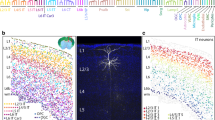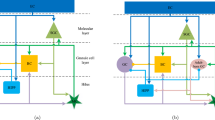Summary
The postnatal development (day of birth up to the end of the third month) of neurohypophyseal pituicytes and tanycytes of the median eminence (ME) and the medial basal hypothalamus (MBH) was studied immunohistochemically in the Mongolian gerbil (meriones unguiculatus) with antibodies directed against glial fibrillary acidic protein (GFAP; the major protein subunit of glial filaments). Weak GFAP-immunoreactivity (IR) was scattered in the neural lobe (NL), the ME and the lining of the ventral 3rd ventricle at the first postnatal days. By the end of the second postnatal week, the intensity of the IR had reached a level comparable to that of adult animals. Generally, in the whole neurohypophysis a cytoarchitectonic pattern, which essentially corresponded to adult conditions, was reached around the beginning of the second month. During the first week postnatum, solely perinuclear stainings, mostly unipolar pituicytes with short processes and isolated fibers were discernible in the NL. In the course of the second and third postnatal week, a growing number of the densely arranged pituicytes appeared in form of bi- and multipolar cells. Thickness and length of pituicyte processes, as well as their degree of branching, increased progressively in the first month. The number of GFAP-positive tanycytes in the ventral 3rd ventricle and in the ME most markedly augmented in the first week postnatum. In the MBH, long tanycyte processes emerged from the ventricular lining to cross the arcuate nucleus in large bows, delimiting groups of neurons. Ependymal and subependymal tanycytes in the ME gave rise to radial processes extending to the external zone. Moreover, in this zone several tanycyte-like cells, whose number increased considerably in the second postnatal week, contributed to the palisadal arrangement of glial processes. In the third month, the arcuate nucleus was still penetrated by many immunopositive tanycyte processes. It was characteristic of the adult staining pattern that the highly branched processes of tanycytes and tanycyte-like cells in the ME were thicker and more variable in size than the less densely arranged tanycyte processes of the MBH. The postnatal increase of GFAP-IR intensity was paralleled by a similar development of vasopressin-IR in the ME and NL, indicating that the maturation of neurohypophyseal glia is closely linked to the functional differentiation of the neurosecretory axons.
Similar content being viewed by others
References
Akmayev IG, Fidelina OV, Kabolova ZA, Popov AP, Schitkova TA (1973) Morphological aspects of the hypothalamic-hypophyseal system IV. Medial basal hypothalamus. An experimental morphological study. Z Zellforsch 137:493–512
Altman J, Bayer SA (1978) Development of the diencephalon in the rat. III. Ontogeny of the specialized ventricular linings of the hypothalamic third ventricle. J Comp Neurol 182:995–1016
Basco E, Woodhams PL, Hajos F, Balazs R (1981) Immunocytochemical demonstration of glial fibrillary acidic protein in mouse tanycytes. Anat Embryol 162:217–222
Bitsch P, Schieber TH (1979) Zur postnatalen Entwicklung der Eminentia mediana der Ratte. Z Mikrosk Anat Forsch 93:1–20
Brawer JR (1972) The fine structure of the ependymal tancycytes at the level of the arcuate nucleus. J Comp Neurol 145:25–42
Bruni JE, Clattenburg RE, Millar E (1983) Tanycyte ependymal cells in the third ventricle of young and adult rats: a Golgi study. Anat Anz 153:53–68
Cannata MA, Tramezzani JH (1977) Ultrastructural maturation of the neurohypophysis of the rat. Acta Anat 97:213–223
Dahl D, Bignami A (1983) The glial fibrillary acidic protein and astrocytic 10-nanometer filaments. In: Lajtha A (ed) Handbook of neurochemistry, vol 5. Plenum Press, New York, pp 127–151
Dellmann HD, Sikora K (1981) Pituicyte fine structure in the developing neural lobe of the rat. Dev Neurosci 4:89–97
De Vitry F, Picart R, Jacque C, Tixier-Vidal A (1981) Glial fibrillary acidic protein. A cellular marker of tanycytes in the mouse hypothalamus. Dev Neurosci 4:457–460
Dixon RG, Eng LF (1981) Glial fibrillary acidic protein in the retina of the developing albino rat: an immunoperoxidase study of paraffin-embedded tissue. J Comp Neurol 195:305–321
Eng LF (1985) Glial fibrillary acidic protein (GFAP): the major protein of glial intermediate filaments in differentiated astrocytes. J Neuroimmunol 8:203–214
Eng LF, DeArmond SJ (1983) Immunochemistry of the glial fibrillary acidic protein. In: Zimmerman HM (ed) Progress in neuropathology, vol 5. Raven Press, New York, pp 19–39
Flament-Durand J, Brion JP (1985) Tanycytes: morphology and functions: a review. Int Rev Cytol 96:121–155
Galabov P, Schiebler TH (1978) The ultrastructure of the developing neural lobe. Cell Tissue Res 189:313–329
Harry GJ, Goodrum JF, Morell P (1985) The postnatal development of glial fibrillary acidic protein and neurofilament triplet proteins in rat brain stem. Int J Dev Neurosci 3:349–352
Joy KP, Sathyanesan AG (1981) A Golgi-Cox study of tanycytes in the hypothalamic region of the third ventricle in the wild rat, Rattus rattus rattus (L.). Acta Anat 111:296–304
Kosaka T, Hama K (1986) Three-dimensional structure of astrocytes in the rat dentate gyrus. J Comp Neurol 249:242–260
Pixley SKR, De Vellis J (1984) Transition between immature radial glia and mature astrocytes studied with a monoclonal antibody to vimentin. Dev Brain Res 15:201–209
Rafols JA (1986) Ependymal tanycytes of the ventricular system in vertebrates. In: Fedoroff S, Vernadakis A (eds) Astrocytes, vol 1. Academic Press, New York, pp 131–148
Redecker P (1987) Golgi-like immunostaining of pituicytes and tanycytes positive for glial fibrillary acidic protein in the neurohypophysis of the Mongolian gerbil (Meriones unguiculatus). Histochemistry 87:585–595
Redecker P (1989) Immunogold electron microscopic localization of glial fibrillary acidic protein (GFAP) in neurohypophyseal pituicytes and tanycytes of the Mongolian gerbil (Meriones unguiculatus). Histochemistry 91:333–337
Redecker P, Hoffmann K (1988) Distributional pattern of oxytocin-and vasopressin-immunoreactivity in the neurohypophysis of the Djungarian hamster (Phodopus sungorus). Cell Tissue Res 253:677–682
Redecker P, Wittkowski W, Hoffmann K (1987) Glial cells positive for glial fibrillary acidic protein in the neurohypophysis of the Djungarian hamster (Phodopus sungorus). An immunohistochemical and ultrastructural study. Cell Tissue Res 249:465–471
Roessmann U, Gambetti P (1986) Astrocytes in the developing human brain. An immunohistochemical study. Acta Neuropathol 70:308–313
Roessmann U, Velasco ME, Sindely SD, Gambetti P (1980) Glial fibrillary acidic protein (GFAP) in ependymal cells during development. An immunohistochemical study. Brain Res 200:13–21
Rützel H, Schiebler TH (1980) Prenatal and early postnatal development of the glial cells in the median eminence of the rat. Cell Tissue Res 211:117–137
Salm AK, Hatton GI, Nilaver G (1982) Immunoreactive glial fibrillary acidic protein in pituicytes of the rat neurohypophysis Brain Res 236:471–476
Schmechel DE, Rakic P (1979) A Golgi study of radial glial cells in developing monkey telencephalon: morphogenesis and transformation into astrocytes. Anat Embryol 156:115–152
Seress L (1980) Development and structure of the radial glial in the postnatal rat brain. Anat Embryol 160:213–226
Sturrock RR (1986) Postnatal ontogenesis of astrocytes, In: Fedoroff S, Vernadakis A (eds) Astrocytes, vol 1. Academic Press, New York, pp 75–103
Suarez I, Fernandez B, Bodega G, Tranque P, Olmos G, Garcia-Segura LM (1987) Postnatal development of glial fibrillary acidic protein immunoreactivity in the hamster arcuate nucleus. Dev Brain Res 37:89–95
Suess U, Pliska V (1981) Identification of the pituicytes as astroglial cells by indirect immunofluorescence-staining for the glial fibrillary acidic protein. Brain Res 221:27–33
Trojanowski JQ, Gordon D, Obrocka M, Lee VMY (1984) The developmental expression of neurofilament and glial filament proteins in the human pituitary gland: an immunohistochemical study with monoclonal antibodies. Dev Brain Res 13:229–239
Velasco ME, Roessmann U, Gambetti P (1982) The presence of glial fibrillary acidic protein in the human pituitary gland. J Neuropathol Exp Neurol 41:150–163
Walsh RJ, Brawer JR, Lin PS (1978) Early postnatal development of ependyma in the third ventricle of male and female rats. Am J Anat 151:377–408
Wittkowski W (1967) Kapillaren und perikapilläre Räume im Hypothalamus-Hypophysen-System und ihre Bezichungen zum Nervengewebe. Z Zellforsch 81:344–360
Wittkowski W (1980) Glia der Neurohypophyse. In: Oksche A, Vollrath L (eds) Handbuch der mikroskopischen Anatomie des Menschen, 4. Band, 10. Teil. Springer, Berlin Heidelberg New York, pp 667–756
Wittkowski W (1986) Pituicytes. In: Fedoroff S, Vernadakis A (eds) Astrocytes, vol 1. Academic Press, New York, pp 173–208
Wittkowski W, Bergmann M, Hoffmann K, Pera F (1988) Photoperiod-dependent changes in TSH-like immunoreactivity of cells in the hypophysial pars tuberalis of the Djungarian hamster, Phodopus sungorus. Cell Tissue Res 251:183–187
Author information
Authors and Affiliations
Rights and permissions
About this article
Cite this article
Redecker, P. Postnatal development of glial fibrillary acidic protein (GFAP) immunoreactivity in pituicytes and tanycytes of the Mongolian gerbil (Meriones unguiculatus). Histochemistry 91, 507–515 (1989). https://doi.org/10.1007/BF00492524
Received:
Issue Date:
DOI: https://doi.org/10.1007/BF00492524




